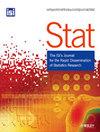预测原发性开角型青光眼的深度学习模型
IF 0.8
4区 数学
Q3 STATISTICS & PROBABILITY
引用次数: 0
摘要
青光眼是全球失明和视力受损的主要原因,而视野(VF)测试对于监测青光眼的转归至关重要。以往的研究主要侧重于使用单个时间点的视野数据进行青光眼预测,而对纵向轨迹的探索还很有限。此外,许多深度学习技术将时间到青光眼的预测视为二元分类问题(青光眼是/否),导致将一些删减的受试者误分类为非青光眼类别,降低了预测效果。为了应对这些挑战,我们提出并实施了几种深度学习方法,这些方法自然地结合了纵向 VF 数据中的时间和空间信息来预测青光眼的发生时间。在眼压治疗研究(OHTS)数据集上进行评估时,我们提出的卷积神经网络(CNN)-长短期记忆(LSTM)成为所有受检模型中表现最佳的模型。实现代码可在线查阅(https://github.com/rivenzhou/VF_prediction)。本文章由计算机程序翻译,如有差异,请以英文原文为准。
Deep learning models to predict primary open-angle glaucoma
Glaucoma is a major cause of blindness and vision impairment worldwide, and visual field (VF) tests are essential for monitoring the conversion of glaucoma. While previous studies have primarily focused on using VF data at a single time point for glaucoma prediction, there has been limited exploration of longitudinal trajectories. Additionally, many deep learning techniques treat the time-to-glaucoma prediction as a binary classification problem (glaucoma Yes/No), resulting in the misclassification of some censored subjects into the nonglaucoma category and decreased power. To tackle these challenges, we propose and implement several deep-learning approaches that naturally incorporate temporal and spatial information from longitudinal VF data to predict time-to-glaucoma. When evaluated on the Ocular Hypertension Treatment Study (OHTS) dataset, our proposed convolutional neural network (CNN)-long short-term memory (LSTM) emerged as the top-performing model among all those examined. The implementation code can be found online (https://github.com/rivenzhou/VF_prediction).
求助全文
通过发布文献求助,成功后即可免费获取论文全文。
去求助
来源期刊

Stat
Decision Sciences-Statistics, Probability and Uncertainty
CiteScore
1.10
自引率
0.00%
发文量
85
期刊介绍:
Stat is an innovative electronic journal for the rapid publication of novel and topical research results, publishing compact articles of the highest quality in all areas of statistical endeavour. Its purpose is to provide a means of rapid sharing of important new theoretical, methodological and applied research. Stat is a joint venture between the International Statistical Institute and Wiley-Blackwell.
Stat is characterised by:
• Speed - a high-quality review process that aims to reach a decision within 20 days of submission.
• Concision - a maximum article length of 10 pages of text, not including references.
• Supporting materials - inclusion of electronic supporting materials including graphs, video, software, data and images.
• Scope - addresses all areas of statistics and interdisciplinary areas.
Stat is a scientific journal for the international community of statisticians and researchers and practitioners in allied quantitative disciplines.
 求助内容:
求助内容: 应助结果提醒方式:
应助结果提醒方式:


